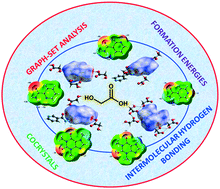Recurrent motifs in pharmaceutical cocrystals involving glycolic acid: X-ray characterization, Hirshfeld surface analysis and DFT calculations†
Abstract
Over the past several decades, the possibility of joining together compounds in one crystal lattice via well-defined intermolecular forces to shape drug-delivery relevant features, e.g. solubility, has fuelled the development of crystal engineering in both the academia and the pharmaceutical industry. Cocrystal approaches are particularly useful if both components feature bioactivity and are well tolerated. Cocrystals of glycolic acid (GA) with picolinamide (PA), nicotinamide (NA), isonicotinamide (INA), caffeine (CA), a theophylline (TP) solvate with formamide (FA) and an ammonium glycolate solvate with glycolic acid were prepared and characterized by elemental analysis, X-ray powder diffraction, IR and NMR spectroscopy, and single crystal X-ray diffraction. The prepared compounds had the compositions [NH4][GA–H]·(GA) (1), (PA)/(GA) (2), 2(NA)/(GA) (3), (IN)/(GA) (4), (CA)/2(GA) (5) and (TP)·(FA) (6). The self-assembled supramolecular architectures were governed by hydrogen bonds and, in some cases, by aromatic donor–acceptor interactions. The analysis of the crystalline structures revealed the existence of characteristic heterosynthons, with the hydrogen bonding motif R22(8) (primary amide–carboxylic acid) being the most common between the molecules of the pyridinecarboxamides and the glycolic acid. Synthons featuring different graph set motifs, involving N–H⋯O, O–H⋯N and N–H⋯N bonds, also manifest themselves among the coformer molecules. Hirshfeld surface analysis revealed that the contribution of O⋯H/H⋯O contacts of the GA molecule is largely dependent on the structure of the amide component and, particularly, on its ability to form cyclic hydrogen-bonded ring motifs. The effect of the protonation state of glycolic acid molecules on the HS and 2D fingerprint plot properties was found to be limited. The thermal behaviour of the cocrystals and pure conformers was studied by thermogravimetry and differential scanning calorimetry. The contribution of each individual hydrogen bond to the formation energies of the supramolecular assemblies observed in the solid state of compounds 2–6 was estimated using the quantum theory of “atoms-in-molecules”. This methodology allowed us to identify the energetically most favourable H-bonds. We have tested two energy predictors based on the AIM energies at the bond CPs and the one using the Lagrangian kinetic energy was more reliable.



 Please wait while we load your content...
Please wait while we load your content...